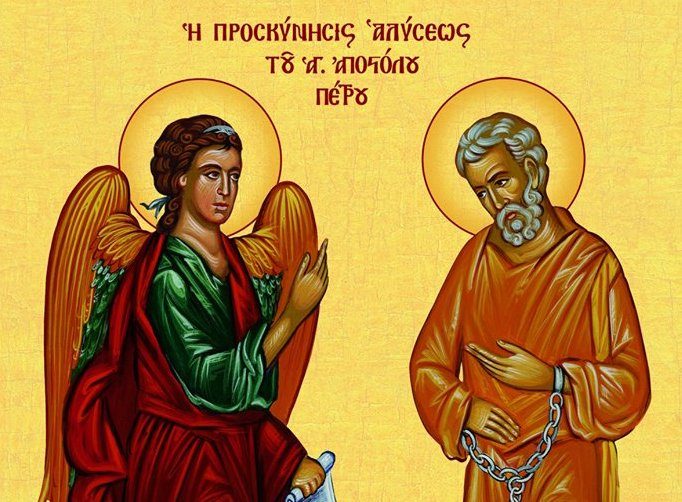Veneration of the Precious Chains of the Holy and All-Glorious Apostle Peter (16 January)

The Veneration of the Honorable Chains of the Holy and All-Praised Apostle Peter: In about the year 42, on the orders of Herod Agrippa, the Apostle Peter was thrown into prison for preaching about Christ the Savior. In prison he was held secure by two iron chains. During the night before his trial, an angel of the Lord removed these chains from the Apostle Peter and led him out from the prison (Acts 12:1-11).
Christians who learned of the miracle took the chains and kept them as precious keepsakes. For three centuries the chains were kept in Jerusalem, and those who were afflicted with illness and approached them with faith received healing. Patriarch Juvenal (July 2) presented the chains to Eudokia, wife of the emperor Theodosius the Younger, and she in turn transferred them from Jerusalem to Constantinople in either the year 437 or 439.
Eudokia sent one chain to Rome to her daughter Eudoxia (the wife of Valentinian), who built a church on the Esquiline hill dedicated to the Apostle Peter and placed the chain in it. There were other chains in Rome, with which the Apostle Peter was shackled before his martyrdom under the emperor Nero. These were also placed in the church.
On January 16, the chains of Saint Peter are brought out for public veneration.
Herod Agrippa, the grandson of Herod the Great and king of the Jews, grew wroth against the Church of Christ, and slew James, the brother of John the Evangelist. Seeing that this pleased the Jews, he took Peter also into custody and locked him up in prison, intending to keep him there until after the feast of the Passover, so that he could win the favour of the people by presenting him to them as a victim. But the Apostle was saved when he was miraculously set free by an Angel (Acts 12:1-19). The chains wherewith the Apostle was bound received from his most sacred body the grace of sanctification and healing, which is bestowed upon the faithful who draw nigh with faith.
That such sacred treasures work wonders and many healings is witnessed by the divine Scripture, where it speaks concerning Paul, saying that the Christians in Ephesus had such reverence for him, that his handkerchiefs and aprons, taken up with much reverence, healed the sick of their maladies: “So that from his body were brought unto the sick handkerchiefs or aprons, and the diseases departed from them, and the evil spirits went out of them” (Acts 19:12). But not only the Apostles’ clothing (which certainly touched the bodies of the sick), but even their shadow alone performed healings. On beholding this, people put their sick on stretchers and beds and brought them out into the streets that, when Peter passed by, his shadow “might overshadow some of them”(Acts 5:15). From this the Orthodox Catholic Church has learned to show reverence and piety not only to the relics of their bodies, but also in the clothing of God’s Saints.
St. Peter is commemorated on this day because of the chains with which he was shackled by the lawless Herod and which fell from him during the appearance of an angel in prison: Suddenly the angel of the Lord stood by him and a light shone in the cell. He tapped Peter on the side and awakened him, saying, ‘Get up quickly.’ The chains fell from his wrists (Acts of the Apostles 12:7). The chains were preserved by Christians as much for the memory of this great apostle as for their healing power, for many of the sick were healed by touching them, as was the case with the apron of the Apostle Paul: then when the face cloths or aprons that touched his skin were applied to the sick, their diseases left them and the evil spirits came out of them (Acts 19:12). St. Juvenal, the Patriarch of Jerusalem, gave these chains as a gift to the Empress Eudocia, the exiled wife of the Emperor Theodosius the Younger. She divided them into two and sent one half to the Church of the Holy Apostle in Constantinople and the other half to Rome, to her daughter, Empress Eudoxia, the wife of Valentian. Eudoxia built the Church of St. Peter and placed these chains in it, together with those chains with which Peter was shackled before his death under Emperor Nero.
Apolytikion of Veneration of the Chains of Ap. Peter
Second Tone
Without leaving Rome, thou didst come to us by the precious chains which thou didst wear. O foremost of the Apostles. And venerating them with faith, we pray: By thine intercessions with God, grant us great mercy.
Kontakion of Veneration of the Chains of Ap. Peter
Second Tone
Now Christ God, the Rock, doth glorify the rock of faith, illustriously, in calling all to celebrate the dread wonders of the most precious chains of Peter, the first and chief of the disciples of Christ our God, Who granteth forgiveness of sins unto all.
Source: oca.org / goarch.org / westserbdio.org




